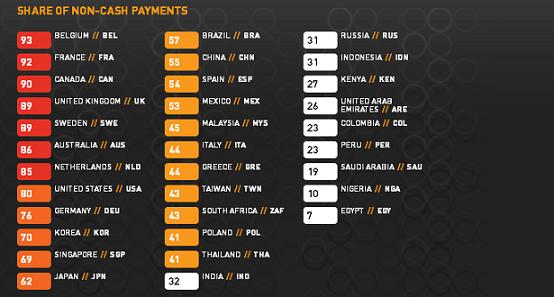
Cultural behavior appears to be keeping cash usage higher than market conditions would suggest, according to the latest MasterCard Study. Belgium, France and Canada closest to cashless societies – China and UAE with the fastest trajectory (a measure of the shift in cash share of consumer payments’ value between 2006 and 2011).
MasterCard today unveiled a new global report, “The Cashless Journey,” that tracks how 33 major economies are progressing from cash-based to cashless societies. The report, produced by MasterCard Advisors, identifies new technologies, government programs and consumer preferences as key factors that are driving this shift, creating more productive and inclusive economies.
The study focuses on the value of all consumer payments ($63 trillion in total spend), including those that happen beyond retail point-of-sale. In 2011, 34 percent ($21 trillion) of total global consumer spend was done with cash, with cashless payments accounting for 66 percent ($42 trillion).
The report identifies Belgium (where an estimated 93% of the value of consumer spend was cashless), France (92%), Canada (90%), the UK (89%), Sweden (89%), Australia (86%) and the Netherlands (85%) as countries where cashless payments are nearly ubiquitous, and attributes the broad movement away from cash to the uptake of new cashless payment technologies such as mobile, contactless and EMV Chip and a modern payments infrastructure.
Countries such as the United States (where an estimated 80% of the value of consumer spend was cashless) and Singapore (69%) are approaching the “tipping point” to becoming nearly cashless, and remaining cash use is largely a product of consumer habit. Conversely, emerging economies such as Indonesia (31%), Russia (31%) and Egypt (7%) are just embarking on their cashless journey, but are in many cases changing cash share of payments at a much faster pace than developed nations.
Having relatively recently put all the elements of a modern consumer payments infrastructure in place, countries such as Brazil (57%), Poland (41%) and South Africa (43%) are now in a transitioning stage, and are quickly shifting share away from cash.
The most rapid recent shift away from cash was observed in China, where cash share of the value of consumer payments is estimated to have declined by as much as 20 percent between 2006 and 2011. China (where an estimated 55% of the value of consumer spend was cashless) and the United Arab Emirates (26%) are among a group of countries where the respective governments have taken strong leadership in promoting electronic payments to support their social and economic goals. Kenya (27%) is an example where disruptive technology is contributing the most to decrease cash share of consumer spend.
“What seems to be overlooked in the policy dialogue is that cash takes time to access, is riskier to carry, and costs a country up to 1.5 percent of its GDP. We can’t expect the journey from cash toward electronic payments to be completed overnight, yet driven by technological advances and public-private partnerships this trend has gathered significant momentum over the past few years,” said Peer Stein, Director of Access to Finance Advisory Services at the International Finance Corporation.
MasterCard Advisors’ research indicates that how ready a country is to move to a cashless society is determined by factors like the accessibility and affordability of financial services; the scale and market share of retailers; the level of technology that is available; and participation of consumers in the formal economy. However, in countries such as Germany (where an estimated 76% of the value of consumer spend was cashless), Japan (62%), Spain (54%) and Taiwan (43%), cultural behavior appears to be keeping cash usage higher than market conditions would suggest.
Methodology:
The “Cashless Journey” report measure nations’ progress towards more modern, efficient payment processes by looking at the current share of cash versus non-cash payments for consumers (Share), how this share has shifted in the past five years (Trajectory), and whether conditions exist for cash payments to move to electronic (Readiness).
The report measure three components of progress:
1. Share: the percentage of the value of all consumer payments (including utility, government, medical, loan, P2P payments for goods or services as well as merchant payments at retail point of sale) that are presently done by a means other than cash
2. Trajectory: a measure of the shift in cash share of consumer payments’ value between 2006 and 2011
3. Readiness: a measure of the future potential for conversion of cash payments to electronic payments
Banking 4.0 – „how was the experience for you”
„To be honest I think that Sinaia, your conference, is much better then Davos.”
Many more interesting quotes in the video below: